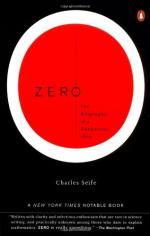
|
| Name: _________________________ | Period: ___________________ |
This quiz consists of 5 multiple choice and 5 short answer questions through Chapter 7.
Multiple Choice Questions
1. What god within Hinduism represents both creator and destroyer?
(a) Ganesha.
(b) Shiva.
(c) Kartikeya.
(d) Pavarti.
2. Bishop Berkeley was a philosopher whose primary achievement was the advancement of a theory he called what?
(a) “Calculus.”
(b) “The Golden Ratio.”
(c) "Immaterialism."
(d) “String theory.”
3. Who founded the House of Wisdom that was established in Abbasid-era Baghdad, Iraq?
(a) Sahl ibn Harun.
(b) Muhammad ibn Mūsā al-Khwārizmī.
(c) Caliph Harun al-Rashid.
(d) Hunayn ibn Ishaq.
4. The introduction of nothingness and zero into Jewish theology led in part to what offshoot Jewish mysticism?
(a) Orthodoxy.
(b) Kabbalism.
(c) Sufism.
(d) Hasidism.
5. When the Indians adopted a Babylonian style number system, its base was what, according to the author in Chapter 3, “Nothing Ventured”?
(a) 10.
(b) 20.
(c) 5.
(d) 60.
Short Answer Questions
1. What term refers to the religious or philosophical concept that the soul is reborn after biological death?
2. The Rayleigh–Jeans law agrees with experimental results at large wavelengths but strongly disagrees at short wavelengths. What is this inconsistency known as?
3. According to the author in Chapter 7, “Absolute Zeros,” Max Planck came up with a new equation that solved the ultraviolet catastrophe but implied that energy was released in discrete packets that have come to be called what?
4. What principle holds that there is an inverse relation between the fineness with which a particular's location can be determined and the fineness with which its velocity can be determined?
5. According to the author in Chapter 7, “Absolute Zeros,” thermodynamics have taught us that there are many things we cannot do, such as building what?
|
This section contains 285 words (approx. 1 page at 300 words per page) |

|




